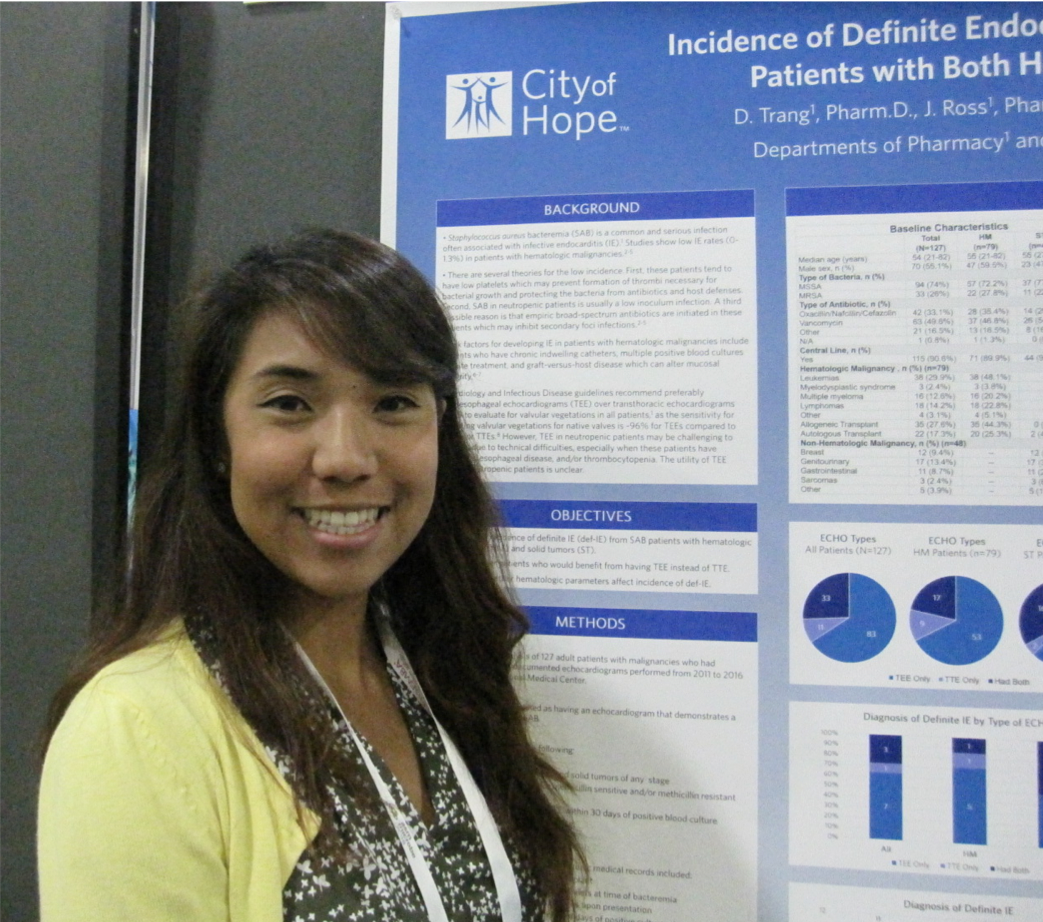Infective Endocarditis More Common in Patients With Hematologic Malignancies Than Originally Thought
The incidence of IE was lower in patients having a lower white blood cell count and lower numbers of platelets.

Dina Trang, PharmD, stands next to her poster at ASM Microbe 2018.
The retrospective findings of a single-center study have given pause for thought when it comes to infective endocarditis (IE) in patients with hematologic malignancies. Although the occurrence of IE, particularly those infections that are due to Staphylococcus aureus, has reportedly been low (around 1% of patients), this latest data presented at the 2018 ASM Microbe meeting may turn this assumption upside down.
“Previous studies evaluating the incidence of IE show very low rates of IE in patients with hematologic malignancies. In this retrospective, single-center study, the incidence of definite IE in such patients was higher than expected,” said Dina Trang, PharmD, City of Hope National Medical Center, Duarte, California, who presented the poster, when she spoke with Contagion®.
The latest finding has real meaning for patients. Transesophageal echocardiogram (TEE) is recommended instead of a transthoracic echocardiogram (TTE) to reveal the presence of infections growing in heart valves. This is because TEE is more sensitive than TTE in visualizing the clumps of bacteria—termed vegetations in the medical lingo.
In patients with fewer than normal numbers of neutrophils, TEE can be difficult to perform. “The patients can be medically unstable and require an infusion of platelets as their levels are low. These patients are really sick and preparing them for TEE has risks,” explained Dr. Trang.
Avoiding the procedure was assumed to be okay, since the presumption has been that IE is relatively scant. The present study was done to explore this presumption.
“We sought to evaluate the incidence of definite IE from patients with Staphylococcus aureus bacteremia and hematologic malignancies and from those with solid tumors. The aim was to identify cancer patients who would benefit from having TEE instead of TTE and to determine whether hematologic parameters affect the incidence of definite IE,” said Dr. Trang.
The researchers took a retrospective look at 127 adult patients treated at City of Hope between 2011 and 2016. All were 18 years of age or older with hematologic malignancies (mainly leukemia) and solid tumors at any stage. They also had positive blood culture confirmation of methicillin-sensitive or resistant S aureus and had received a TTE and/or TEE within 1 month of the positive culture. Definite IE was considered to be the presence of bacterial vegetation on a heart valve as revealed in an echocardiogram.
The patients with hematologic malignancies (n = 79) or solid tumors (n = 48) were comparable in terms of age (around 55 years), male prevalence, a predominance of methicillin-sensitive S aureus (around 75% of cases), and antibiotics used (vancomycin in about 50% of the cases). The groups differed when it came to allogeneic transplantation, which was not done for the solid tumor patients.
Echocardiography was predominantly TEE in both groups, with about 16% of patients in both groups receiving both TEE and TTE. Definite IE was diagnosed in 11 patients, with 7 cases in those with hematologic malignancies and 4 in patients with solid tumors.
The small numbers ruled out statistical rigor of any comparison. “Yes, it is a small study. Originally, there were more patients. But, it was decided to include only those with confirmed infective endocarditis with the presence of vegetations. So, even though the number of patients may be small, the data presented are really meaningful,” explained Dr. Trang.
The incidence of IE was lower in patients having a lower white blood cell count and lower numbers of platelets. Seven of the 11 patients with definite IE had bacteremia, with the other 4 having more prolonged bacteremia of 4to 5 days. S aureus bacteremia was associated with a 30-day mortality rate of about 12%; however, in 11 patients with definite IE, the 30-day mortality rate was much higher, at 55%.
Although the interpretation of the findings is hampered by the small numbers and resulting absence of statistical rigor, the finding of a lower incidence of IE in patients with lower white blood cell count and platelets is consistent with the previously proposed view that platelet counts need to be at a level sufficient to allow the formation of thrombi. The thrombi support the growth of the infecting bacteria and protect them from host defenses and antibiotics.
The finding that the collection of just 1 blood culture was linked to a lower incidence of IE compared to the drawing of multiple blood cultures is consistent with the previous finding that the use of a maintained central line, which is more convenient when drawing multiple samples over time, is a risk factor for IE.
“Based on these findings, TEE should be considered for patients with hematologic malignancies with S aureus bacteremia in the context of higher than expected rate of IE in our study. Further study looking at other bloodstream infections commonly associated with IE may be warranted,” said Dr. Trang.
DISCLOSURES
none
PRESENTATIONS
SATURDAY -690 poster
Abstract Title:
Incidence of Definite Endocarditis with Staphylococcus aureus Bacteremia among Patients with Both Hematologic and Non-Hematologic Malignancies
D. Trang, City of Hope National Medical Center, Duarte, CA
Brian Hoyle, PhD, is a medical and science writer and editor from Halifax, Nova Scotia, Canada. He has been a full-time freelance writer/editor for over 15 years. Prior to that, he was a research microbiologist and lab manager of a provincial government water testing lab. He can be reached at hoyle@square-rainbow.com
